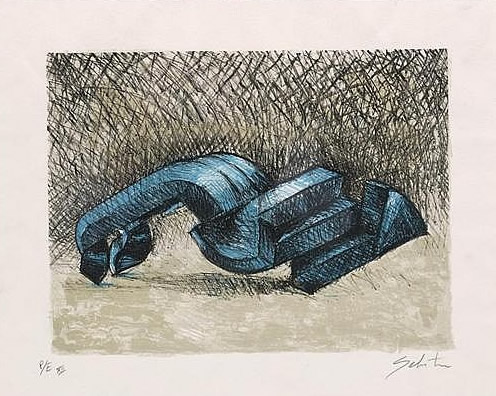Sebastián 'Chac Mool', 2002, spray painted mild steel
Donated by the artist, supported by The Embassy of Mexico in Ireland
Location: Lincoln Gate entrance to campus
Formally unveiled by Provost Patrick Prendergast and H.E. Ambassador Carlos García de Alba in the presence of the artist on the 18th of September 2015 to mark 40 years of Mexican-Irish Diplomatic Relations
Bite-sized info:
 Enrique Carbajal González was born in Chihuahua, Northern Mexico, shortly after the end of the Second World War. The artist adopted the pseudonym ‘Sebastián’ after the painting of the martyred Saint Sebastian by Sandro Botticelli. He is best known for his monumental public sculptures, created using steel or concrete, which can now be seen throughout the world. There are currently four of these sculptures in Ireland, all of which have been generously donated by the artist.
Enrique Carbajal González was born in Chihuahua, Northern Mexico, shortly after the end of the Second World War. The artist adopted the pseudonym ‘Sebastián’ after the painting of the martyred Saint Sebastian by Sandro Botticelli. He is best known for his monumental public sculptures, created using steel or concrete, which can now be seen throughout the world. There are currently four of these sculptures in Ireland, all of which have been generously donated by the artist.
The term Chac Mool refers to a style of ancient Mesoamerican sculpture found in temples and sacred sites throughout Central Mexico. Appearing as a vehicle between man and the gods, it traditionally depicts a reclining figure with its legs bent upwards, resting on its elbows and with its face looking out over its shoulder. This specific type of sculpture was discovered in the 19th century by an archaeologist who named it after the greatest Mayan warrior, Chac Mool. As the artist explains, the colour blue was traditionally used to signify members of the priesthood in ancient frescoes and manuscripts. Although there has been little agreement by historians and anthropologists as to the function or meaning of these ancient sculptures, one interpretation is that they were created to commemorate fallen warriors and allow others to offer gifts to the gods in their memory.
Here on campus, Sebastián’s Chac Mool reinforces a powerful sculptural lineage, associating itself most particularly with Henry Moore’s work entitled Reclining Connected Forms (1969). Moore stated that, from an early stage, he was captivated by Mexican sculpture, particularly by the Chac Mool figure, leading him in 1929 to carve his own Chac Mool in Hornton stone which he later described as one of the key works of his career, from which his renowned reclining figures developed. Sebastián’s turquoise Chac Mool is a vital, contemporary invitation to engage with figure, form, colour and sculpted space within a rich visual arts ancestry.

